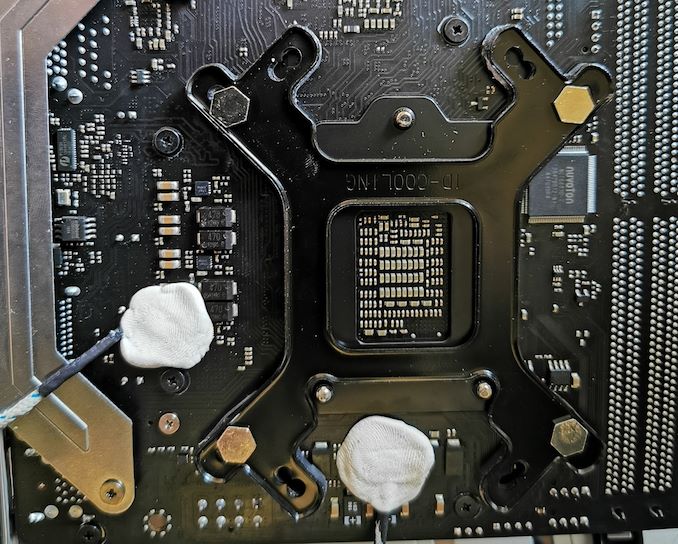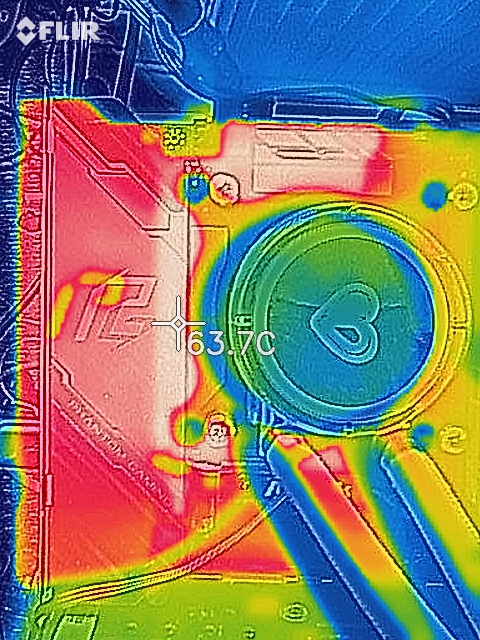AMD + ITX + TB3? It's the ASRock X570 Phantom Gaming-ITX/TB3 Motherboard Review
by Gavin Bonshor on October 9, 2019 12:00 PM ESTPower Delivery Thermal Analysis
One of the most requested elements of our motherboard reviews revolves around the power delivery and its componentry. Aside from the quality of the components and its capability for overclocking to push out higher clock speeds, which in turn improves performance, it is the thermal capability of the cooling solutions implemented by manufacturers that can have the biggest effect. While most solutions are almost always fine for users running processors at default settings, those looking to squeeze out extra performance from the CPU via overclocking put extra pressure on the power delivery. This is why more premium models often include heatsinks on its models with better cooling designs, heftier chunks of metal, and in some cases, even with water blocks such as the ASUS ROG Crosshair VIII Formula.

Two K-Type Thermal Probes attached to the rear of the power delivery on the ASRock X570 Phantom Gaming-ITX/TB3
Testing Methodology
Out method of testing out if the power delivery and its heatsink are effective at dissipating heat, is by running an intensely heavy CPU workload for a prolonged method of time. We apply an overclock which is deemed safe and at the maximum that the silicon on our AMD Ryzen 7 3700X processor allows. We then run the Prime95 with AVX2 enabled under a torture test for an hour at the maximum stable overclock we can which puts insane pressure on the processor. We collect our data via three different methods which include the following:
- Taking a thermal image from a birds-eye view after an hour with a Flir Pro thermal imaging camera
- Securing two probes on to the rear of the PCB, right underneath CPU VCore section of the power delivery for better parity in case a probe reports a faulty reading
- Taking a reading of the VRM temperature from the sensor reading within the HWInfo monitoring application
The reason for using three different methods is that some sensors can read inaccurate temperatures, which can give very erratic results for users looking to gauge whether an overclock is too much pressure for the power delivery handle. With using a probe on the rear, it can also show the efficiency of the power stages and heatsinks as a wide margin between the probe and sensor temperature can show that the heatsink is dissipating heat and that the design is working, or that the internal sensor is massively wrong. To ensure our probe was accurate before testing, I binned 10 and selected the most accurate (within 1c of the actual temperature) for better parity in our testing.
For thermal image, we use a Flir One camera as it gives a good indication of where the heat is generated around the socket area, as some designs use different configurations and an evenly spread power delivery with good components will usually generate less heat. Manufacturers who use inefficient heatsinks and cheap out on power delivery components should run hotter than those who have invested. Of course, a $700 flagship motherboard is likely to outperform a cheaper $100 model under the same testing conditions, but it is still worth testing to see which vendors are doing things correctly.
Thermal Analysis Results

We measured 63.7°C on the hottest part of the board during our testing
The ASRock X570 Phantom Gaming-ITX/TB3 uses a 10-phase power delivery which is running in a 4+2 configuration. The CPU section consists of eight ISL99227 60 A power stages which are paired up with four ISL6617A doublers, while the SoC section consists of two ISL99227 60 A power stages. Controlling the power delivery is a Renesas ISL69147 PWM controller. The cooling solution on the ASRock X570 Phantom Gaming-ITX/TB3 consists of two individual heatsinks; one aluminium heatsink which is a combined piece with the rear panel cover, and a separate SoC section which also cools two of the power stages of the CPU section. It's actually a really nice design as the aluminium rear panel cover is quite beefy and will benefit from cases with good passive airflow. -
Looking at our power delivery thermal testing results, the ASRock X570 Phantom Gaming-ITX/TB3 performs pretty well considering it's using a 10-phase design on such a small mini-ITX sized PCB. There are increased thermal properties to consider when running a high-powered mini-ITX system as condensed componentry tends to generate a little bit more heat than a sparser ATX PCB would. With 1.475 V set on the CPU VCore and the CPU Core Frequency set to 4.1 GHz, our temperatures maxed out at 64°C on ASRock's integrated VRM temperature sensor. Our probe on the rear measured 61°C, with our thermal imaging shot measuring 63.7°C on the hottest part of the power delivery. This is a good result for ASRock and although it doesn't quite have the cooling capabilities as some of the flagship models we have tested so far, for a $240 model with so much power and features on a mini-ITX sized model, temperatures in our testing we're absolutely fine. A processor such as the Ryzen 9 3950X with 16-cores is likely to stress the power delivery more than our Ryzen 7 3700X, but it's not likely to push the VRM temperatures into dangerous waters.











64 Comments
View All Comments
HardwareDufus - Wednesday, October 9, 2019 - link
This board is sooooo close to what I want. However, a 2nd M.2 slot, for a 2nd NVMe drive is necessary. I know it's allot to ask for in an m-ITX board, but it can be done.shabby - Wednesday, October 9, 2019 - link
Next version they add a second nvme slot "oh I wish it had 10gbit lan, almost prefect..."wolrah - Wednesday, October 9, 2019 - link
> Next version they add a second nvme slot "oh I wish it had 10gbit lan, almost prefect..."To be fair, at least something >1gbit *should* have been standard on high-end boards long ago, but for whatever reason no one's integrated it in to a chipset.
Instead we get a compact desktop board that wastes precious space with WiFi. WiFi is for things that move and things that get placed in odd locations where wiring is impractical. Desktop computers are neither of those things. Even if you're one of those screwballs who refuses to plug in a cable or insists on placing your computer in some weird place it's not like WiFi is fast enough that USB would be a bottleneck, so there's no good reason for it to be taking up space on a motherboard.
Hell, actually a M.2 slot would be a win-win there, those who want WiFi can install it instead of a SSD.
DiHydro - Wednesday, October 9, 2019 - link
No, I think he is right. Being able to stick another M.2 drive in there is super helpful, especially as if you leave it open for a cheaper/slower SSD as more of a mass storage option. Personally, I want it for two 2 TB intel drives right off the bat, then I will add another SATA drive if I need it at that point.29a - Thursday, October 10, 2019 - link
just buy a 4 tb samsung29a - Thursday, October 10, 2019 - link
or use sata ssd's for the slower cheap storagewr3zzz - Monday, October 14, 2019 - link
Your obviously have never worked with ITX or even mATX cases. An extra M.2 slot is a godsend vs. the space and cabling headaches of sata drives in SFF.DCide - Wednesday, October 9, 2019 - link
Collectively, these are some of the worst comments I’ve ever seen on AT. This is probably the best mITX motherboard board ever designed - even surpassing ASRock’s excellent X299 boards.16 high-performance cores, nearly 4000 points in Cinebench R15, 64GB of high-speed DD4, 18TB of SSD storage (2TB at 3GB/s and 16TB at 1.5GB/s), 6 USB3 ports (two of them Gen 2), and the first full-speed Thunderbolt 3 ever on an mITX motherboard! In fact, being on AMD, I won’t be shocked if it turns out to run at 40Gbps, rather than the expected 32Gbps (on Intel ATX) or 16Gbps (on Intel mITX).
WiFi is useful on a portable form factor (at minimal expense), while 10GbE generates significant heat and adds nearly $100 to the cost. I think every complaint here can be addressed with proper system design, and Thunderbolt 3 makes all the difference, allowing one to add e.g. 10GbE and USB 3 as needed. In fact, TB3 makes this the first mITX board that can transfer files at 2/3 GB/s (in/out) and operate an eGPU with all 4 PCIe 3.0 lanes!
Ironically, the only significant drawback wasn’t mentioned yet - the lack of an iGPU on Zen 2 (useful e.g. for video encoding) which could free up the PCIe slot/lanes for other uses.
chx1975 - Wednesday, October 9, 2019 - link
The Thunderbolt chip, out of necessity, is the same Intel Titan Ridge you'd find on Intel ATX boards or some laptops. While this motherboard is the first to integrate it, there were reports on various forums of the Gigabyte Titan Ridge card (not the Alpine Ridge) working in AMD motherboards without connecting the special header it has. There is no Titan Ridge LP so the bus speed will be 40gbps and the data speed will be 22gbps. That's the same across all TB3 controllers, except the Alpine Ridge LP where the data speed will be 16gps and the bus speed, I think even after this many years, is simply unknown. 20gbps would make sense but it could be just the 18gbps necessary to run a DisplayPort. But then again, there is no common sense where Intel and Thunderbolt is concerned, noone knows why they gimped the data speed on full speed controllers to 22gbps.DCide - Wednesday, October 9, 2019 - link
No, I agree there’s not much common sense there - even down to questions such as “why is TB3 networking limited to 10Gbps” (and reportedly not even reliable enough for production - I’ve only used it in testing scenarios).I had not heard of the 22gbps data limit, but even if it applies here this motherboard should still be the most flexible and highest performance mITX model available, and (fortunately) could still approach 3GB/s transfer rates.